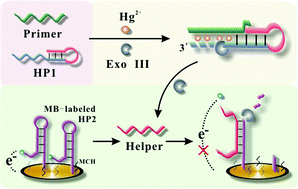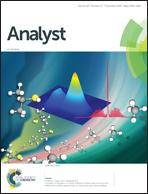Ultrasensitive electrochemical detection of Hg2+ based on an Hg2+-triggered exonuclease III-assisted target recycling strategy
Abstract
In the present work, a simple, rapid, isothermal, and ultrasensitive homogeneous electrochemical biosensing platform for target Hg2+ detection was developed on the basis of an exonuclease III (Exo III)-aided target recycling amplification strategy. In the assay, a label-free hairpin probe (HP1) was ingeniously designed, containing a protruding DNA fragment at the 3′-termini as the recognition unit for target Hg2+. Also, the DNA fragment in the loop region and 5′-termini (Helper) could be used when a secondary target analog is introduced, but it is caged in the stem region of HP1 when without such a target. The produced secondary target Helper opened the methylene blue (MB)-labeled hairpin probe (HP2) and triggered the Exo III cleavage process, accompanied with the secondary target recycling. This accordingly resulted in the autonomous reduction of the electroactive material MB on the electrode, inducing a distinct decrease in the electrochemical signal. The current developed homogeneous strategy provides a means for the ultrasensitive electrochemical detection of Hg2+ down to the 227 pM level, with high selectivity. It could be further used as a general autocatalytic and homogeneous strategy toward the detection of a wide spectrum of analytes and may be associated with more analytical techniques.



 Please wait while we load your content...
Please wait while we load your content...